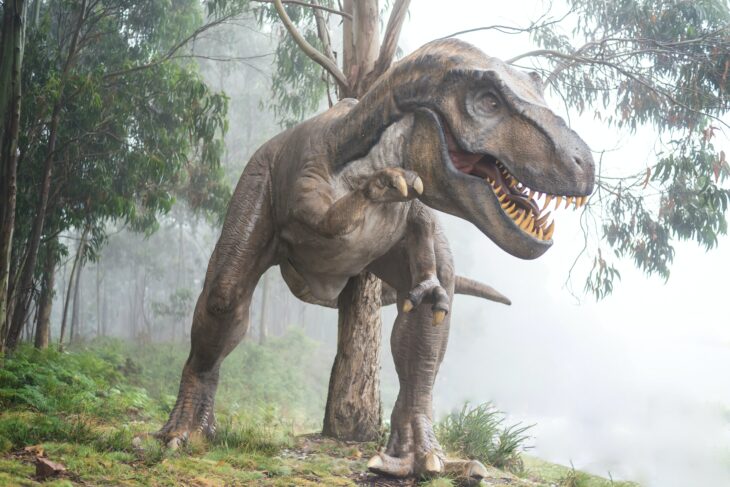Dinosaurs were “monstrous lizards” who dominated Earth for hundreds of millions of years, until an asteroid impact 66 million years ago caused a global mass extinction event. This catastrophe occurred at the transition between the Cretaceous (K) and the Paleogene (Pg) periods, referred to as the K-Pg boundary.
Despite the Hollywood archetype of dinosaurs as cunning predators, paleontologists actually know very little about how smart they were. One way scientists estimate an animal’s intelligence is by comparing its actual brain size with what they expect its brain size should be based on its body size. This metric is called the encephalization quotient, or EQ for short. Humans have large EQs, which is thought to reflect high intelligence.
Soft tissues like brains don’t fossilize, so scientists rely on bones to estimate EQs for extinct species like dinosaurs. Early researchers thought dinosaurs had low intelligence since their brain cases were relatively small compared to their immense skeletons. The EQ metric assumes a universal relationship between brain and body size, but more recent researchers have shown this relationship varies across the animal kingdom, so that assumption is incorrect.
Suzana Herculano-Houzel from Vanderbilt University recently used a new metric to determine how smart dinosaurs were. She calculated the number of neurons in a part of their brains called the pallium. She argued pallial neurons are a reliable way to infer animal intelligence because they control complex behavior and flexible thinking. For example, the number of pallial neurons in birds can predict their problem-solving skills.
This researcher previously determined the number of pallial neurons for a given brain size is similar in animals that evolved from a common ancestor, like gorillas and orangutans. She suggested this scaling relationship could be used to predict the number of pallial neurons from the brain size of related animals.
Paleontologists have established that dinosaurs evolved from the same ancestor as a group of egg-laying animals called sauropsids. Today these include birds and flightless, or nonavian, species like lizards, snakes, and crocodiles. Herculano-Houzel hypothesized she could infer the number of pallial neurons for each dinosaur species from the scaling relationships of living sauropsids if she could determine which ancestral lineage was the best point for comparison.
First, she calculated scaling relationships for different types of modern sauropsids. Using a database of 174 living sauropsids, she defined 3 groups with similar scaling relationships: nonavian sauropsids, birds that evolved before the K-Pg boundary, and birds that evolved more recently. She found recent birds had the most pallial neurons for a given brain size, followed by pre-K-Pg birds, then nonavian sauropsids.
Next, she estimated the brain sizes of dinosaurs from previous studies that compiled inner volumes of fossilized skulls. These studies used an imaging process called computed tomography (what doctors call a CT scan), that creates detailed 3-D images of the inside of a body or fossil using a combination of X-rays and computer technology.
She plotted brain sizes versus published body sizes for each of the fossil species alongside brain versus body sizes for modern sauropsids, to determine which of the 3 sauropsid groups each dinosaur belonged with. She found most of the theropod, or “beast-footed,” dinosaurs like Tyrannosaurus rex clustered with pre-K-Pg birds, while the sauropod, or “lizard-footed,” dinosaurs like Brachiosaurus clustered with nonavian sauropsids. She suggested the dinosaurs’ brains should follow scaling relationships indicated by these clusters.
Finally, she used the corresponding scaling relationships to predict how many pallial neurons each dinosaur had from its brain size. She estimated theropod dinosaurs had over 1 billion pallial neurons, similar to modern primates like baboons, while sauropods had less than 200 million pallial neurons, similar to non-primate mammals like marmosets.
Herculano-Houzel suggested a high number of pallial neurons indicated that large theropods like T. rex had long lifespans and flexible minds, which would have made them highly skilled predators. She speculated these dinosaurs could have been capable of advanced problem-solving, tool use, and even cultural development, like crows and chimpanzees.
While her results seem to support the view of some dinosaurs as super-predators, Herculano-Houzel acknowledged her study had limitations. For one, the fossil studies she used assumed sauropod brains only filled 50% of their brain cases, and theropod brains filled them entirely, so she could have under- or over-estimated their brain sizes, respectively. She suggested improved modeling and CT methods to estimate the size of internal brain structures from fossils would help understand the cognitive abilities of extinct species.


